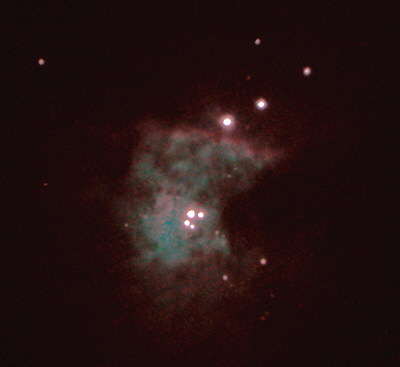
This is a photo of the Trapezium, the central core of the Great Nebula in Orion. This photo was taken using the afocal method, the camera was an Olympus C3030 zoom (digital camera, images taken at 2048x1536 pixels). The scope had a 32mm Plossl eyepiece in line (magnification = 88x). The camera's optical zoom was also set to maximum. The camera was mounted to the scope using a homebrew mount; the camera's remote control was used to trigger the shutter. This shot is the result of 3 stacked 16 second images (images combined in Photoshop). The main problem with using a digital camera for deep sky work is that the CCD in the camera is not cooled (like it is in a conventional CCD camera). Thus, the amount of noise in the image is comparitively high. Also, this digital camera has an exposure limit of 16 seconds. On the plus side, the camera is color (no tri-color techniques required) and the CCD is huge compared to most in conventional telescope CCD cameras. The image below shows that the field of view is rather small and than not too much nebulosity is seen. However, the 4 stars of the Trapezium are clearly visible, these are almost always "blown away" in conventional film shots of this region. So, if you have a suitable digital camera and a reasonably large scope, do experiment! Stay with very bright objects and you may have some acceptable results!

Use your browser's "back" button, or use links below if you arrived here via some other path:
This page is part of the site Joe Roberts Astrophotography Images by Category
E-mail to Joe
Roberts
Images and HTML text © Copyright 2001 by Joe Roberts. Please request permission to use photos for purposes other than "personal use".